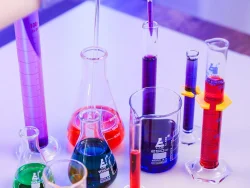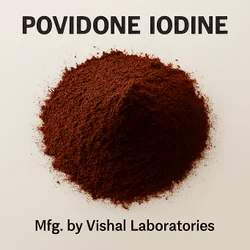Povidone iodine
Synonym(s):Povadyne antiseptic;PVP-I
- CAS NO.:25655-41-8
- Empirical Formula: C6H9I2NO
- Molecular Weight: 364.95
- MDL number: MFCD00084483
- EINECS: 607-771-8
- SAFETY DATA SHEET (SDS)
- Update Date: 2025-12-17 09:49:21

What is Povidone iodine?
Description
Povidone iodine is iodophor, used as topical antiseptic in surgery and for skin and mucous membrane infections, also as aerosol. A 10% povidone iodine solution contains 1% available iodine, but free-iodine is at 0.1% concentration. Skin exposure causes irritant rather than allergic contact dermatitis. In such a situation, however, iodine seems to be the true hapten.
Chemical properties
Povidone iodine is a complex of iodine with povidone. It occurs as a yellowish brown to reddish brown amorphous powder, having a slight characteristic odour. Its solution is acid to litmus. Soluble in water and in alcohol, practically insoluble in chloroform, in carbon tetrachloride, in ether, in solvent hexane, and in acetone. It is an external antiseptic with a broad microbicidal spectrum against bacteria, fungi, viruses, protozoa, and yeasts. This gel has about 1.0% available iodine.
Originator
Betadine ,Purdue Frederick ,US ,1957
History
Povidone iodine (PI) is frequently used during surgical preparation, postoperative wound cleaning and dressing. It was described by Shelaski about seventy years ago (Shelanski and Shelanski, 1956). PI consists of the complex structure of povidone, a polymer that is structurally similar to plasma proteins, and the iodine element, which has antimicrobial properties. The function of polyvinylpyrrolidone (PVP) used as a polymer includes increasing iodine solubility and penetration, decreasing iodine ion concentration and keeping iodine bound. However, PVP does not have antimicrobial properties. Shelanski defined this complex structure as 'iodophor' (Shelanski and Shelanski, 1956).
The Uses of Povidone iodine
Polyvinylpyrrolidone-iodine complex is used as a slow iodine release formulation that iodinates lipids and oxidizes cell compounds such as tyrosine side chains. It is utilized to study microbial decontamination of human donor eyes as well as inactivation of infectious hematopoietic necrosis virus. It is also used as a carbon nanotube coating agent to enhance water solubility. It serves as a topical antiseptic in surgery, as an aerosol for skin and mucous membrane infections and is used to prevent infection in wounds.
Background
Povidone-iodine is a stable chemical complex of polyvinylpyrrolidone (povidone, PVP) and elemental iodine. It contains from 9.0% to 12.0% available iodine, calculated on a dry basis. This unique complex was discovered in 1955 at the Industrial Toxicology Laboratories in Philadelphia by H. A. Shelanski and M. V. Shelanski. During in vitro testing to demonstrate anti-bacterial activity it was found that the complex was less toxic in mice than tincture of iodine. Human clinical trials showed the product to be superior to other iodine formulations. Povidone-iodine was immediately marketed, and has since become the universally preferred iodine antiseptic.
Indications
For topical application in the treatment and prevention of infection in wounds.
What are the applications of Application
Povidone iodine is a broad spectrum antiseptic for topical application. It is used in first aid for minor cuts, grazes, burns, abrasions and blisters. Povidone iodine has broad applications in medicine as a surgical scrub; for pre- and post-operative skin cleansing.
Preparation
Povidone Iodine Solution is an antiseptic and disinfectant agent. The preparation method of povidone iodine: be that 1.17% potassium iodide is dissolved in part water in 10% water by mass percent, 2.34% iodine is added to wherein stirring and dissolving, be mixed with iodine solution standby; 0.01% stability auxiliary agent is dissolved in part water 10% water standby; In complex reaction still, add remaining water, open and stir, dropping into 10.0% polyvinylpyrrolidone k30 dissolves, then substep adds above-mentioned two kinds of solution that prepare, finally add 7.5% solvent normal propyl alcohol, after feeding intake, allow reactant mixture at 20 ℃, react 2 hours, react complete mixture is lowered the temperature and obtained betagen solution.
brand name
Betadine (Alcon); E-Z Prep (Becton Dickinson Microbiology).
Therapeutic Function
Topical antiinfective
Biological Activity
Povidone iodine is a microcide with broad-spectrum activity against bacteria, fungi, viruses, and protozoans. It reduces total anaerobic and aerobic bacterial counts in vitro in dog feces when applied topically as a 10% solution. Povidone iodine decreases bacterial counts and the occurrence of anastomotic leaks in a dog model of emergent resection and anastomosis of the sigmoid colon when applied in situ at a concentration of 10% v/v. Topical administration of povidone iodine (10% v/v) also reduces bacterial counts on the skin of cynomolgus monkeys. Formulations containing povidone iodine have been used to disinfect skin before and after surgery.
Pharmacokinetics
Povidone iodine is a kind of iodine disinfectant which directly cause in vivo protein denaturation, precipitation of bacteria, and further resulting in the death of pathogenic microorganisms. Therefore, it is effective in disinfection and sterilization. It can kill viruses, bacteria, spores, fungi, and protozoa with low toxicity to human. Povidone-iodine aqueous solution has strong pharmacological activity against Staphylococcus aureus, Neisseria gonorrhoeae, Pseudomonas aeruginosa, syphilis, hepatitis B virus, HIV, and Trichomonas vaginalis.
Povidone iodine gel is a gynecological topical semi-mobile colloidal agent made by povidone iodine and hydrophilic matrix. It is a system for maintaining its sustained release. Owing to the continuous release of free iodine, it can enable the skin and mucous membranes to maintain a certain effective concentration of iodine for killing bacteria. It is mainly used for gynecological vaginal infection. It exerted its effect through being miscible with vaginal secretions and further killing the inside pathogenic microorganisms, and thus blocking the spread of sexually transmitted diseases and invasion, as well as treating other infected vaginal diseases caused by other kinds of bacteria.
Published reports on the in vitro antimicrobial efficacy of iodophors demonstrate that iodophors are bactericidal, mycobactericidal, and virucidal but can require prolonged contact times to kill certain fungi and bacterial spores. Three brands of povidone-iodine solution have demonstrated more rapid kill (seconds to minutes) of S. aureus and M. chelonae at a 1:100 dilution than did the stock solution. The virucidal activity of 75–150 ppm available iodine was demonstrated against seven viruses. Other investigators have questioned the efficacy of iodophors against poliovirus in the presence of organic matter and rotavirus in distilled or tapwater. Manufacturers' data demonstrate that commercial iodophors are not sporicidal, but they are tuberculocidal, fungicidal, virucidal, and bactericidal at their recommended use-dilution.
Toxicity
ORAL (LD50): Acute: 8000 mg/kg [Rat]. 8100 mg/kg [Mouse]
Veterinary Drugs and Treatments
Dilute solutions of povidone iodine (1% – 5%) have been utilized for chemical debridement of loose epithelium in canine indolent ulcers. 5% povidone iodine has also been used as an antifungal for fungal keratitis, but must be lavaged from the eye within 5 minutes to prevent damage to corneal epithelium. Generally, povidone iodine is only used once daily and then rinsed off when used in the eye as an anti-fungal. There has also been a renewed interest in utilizing povidone iodine in treating feline herpes keratitis. Solutions of commercially available 10% povidone iodine are diluted in physiologic saline to concentrations of 0.5 – 1% and applied 1 drop twice to four times daily for treatment of chronic feline herpes keratitis and may also be used prophylactically for feline herpes-virus (FHV) cats with a history of recurring ulcer.
Absorption
Povidone-Iodine is intended for topical application and is not absorbed.
Metabolism
Povidone-Iodine is not absorbed or metabolized.
Properties of Povidone iodine
| Melting point: | 300 °C |
| storage temp. | Keep in dark place,Inert atmosphere,Room temperature |
| solubility | H2O: soluble100mg/mL |
| form | Powder |
| color | Yellow-brown |
| Odor | ylsh. brn. amorphous powd., sl. char. odor |
| Water Solubility | Soluble in water, ethyl alcohol, isopropyl alcohol, polyethylene glycol and glycerol. Insoluble in chloroform, carbon tetrachloride, hexane, acetone and petroleum ether. |
| Merck | 13,7784 |
| InChI | InChI=1S/C6H9NO.I2/c1-2-7-5-3-4-6(7)8;1-2/h2H,1,3-5H2; |
| CAS DataBase Reference | 25655-41-8(CAS DataBase Reference) |
| EPA Substance Registry System | Povidone-iodine (25655-41-8) |
Safety information for Povidone iodine
| Signal word | Danger |
| Pictogram(s) |
 Corrosion Corrosives GHS05  Environment GHS09 |
| GHS Hazard Statements |
H315:Skin corrosion/irritation H318:Serious eye damage/eye irritation H411:Hazardous to the aquatic environment, long-term hazard |
| Precautionary Statement Codes |
P264:Wash hands thoroughly after handling. P264:Wash skin thouroughly after handling. P273:Avoid release to the environment. P280:Wear protective gloves/protective clothing/eye protection/face protection. P302+P352:IF ON SKIN: wash with plenty of soap and water. P305+P351+P338:IF IN EYES: Rinse cautiously with water for several minutes. Remove contact lenses, if present and easy to do. Continuerinsing. P332+P313:IF SKIN irritation occurs: Get medical advice/attention. |
Computed Descriptors for Povidone iodine
| InChIKey | FAAHNQAYWKTLFD-UHFFFAOYSA-N |
| SMILES | II.C(N1CCCC1=O)=C |
Povidone iodine manufacturer
Madhu Chemicals
New Products
4,4-Difluoropiperidine hydrochloride tert-butyl 9-methoxy-3-azaspiro[5.5]undecane-3-carboxylate Indole Methyl Resin N-Isopropylurea N,N-Dicyclohexylcarbodiimide(DCC) MELDRUMS ACID 5-METHYLISOXAZOLE-4-CARBOXYLIC ACID Magnessium Bis glycinate Zinc ascorbate 1-bromo-2-butyne 2-acetamidophenol 9(10H)-anthracenone Erythrosin B, 4-Piperidinopiperidine 2-((4-morpholinophenylamino) (methylthio) methylene) malononitrile 2,4-dihydroxybenzaldehyde 3-(4-morpholinophenylamino)-5-amino-1H-pyrazole-4-carbonitrile Methyl 2-methylquinoline-6-carboxylate 2,6-dichloro-4-nitropyridine 4-Bromo-2-chlorobenzonitrile 2-(benzylamino)acetic acid hydrochloride 4-(tert-Butoxycarbonylamino)but- 2-ynoic acid 3,4-dihydro-2H-benzo[b][1,4]dioxepine 1-Phenyl-1-cycloprppanecarboxylicacidRelated products of tetrahydrofuran








You may like
-
 POVIDONE IODINE 99%View Details
POVIDONE IODINE 99%View Details -
 25655-41-8 98%View Details
25655-41-8 98%View Details
25655-41-8 -
 Polyvinylpyrrolidone-iodine complex CAS 25655-41-8View Details
Polyvinylpyrrolidone-iodine complex CAS 25655-41-8View Details
25655-41-8 -
 POVIDONE IODINE CAS Number 25655-41-8View Details
POVIDONE IODINE CAS Number 25655-41-8View Details
25655-41-8 -
 POVIDONE IODINE powder IP/USP / POVIDONE IODINE API / POVIDONE IODINE POWDER (CAS No : 25655-41-8)View Details
POVIDONE IODINE powder IP/USP / POVIDONE IODINE API / POVIDONE IODINE POWDER (CAS No : 25655-41-8)View Details
25655-41-8 -
 Povidone Iodine - Powder 25655-41-8View Details
Povidone Iodine - Powder 25655-41-8View Details
25655-41-8 -
 Purity: 99% Composition: 50 Povidone Iodine Solution, Grade: TechnicalView Details
Purity: 99% Composition: 50 Povidone Iodine Solution, Grade: TechnicalView Details
25655-41-8 -
 Povidone Iodine - Cas 25655-41-8, Packaging Size: 25 Kgs DrumView Details
Povidone Iodine - Cas 25655-41-8, Packaging Size: 25 Kgs DrumView Details
25655-41-8
